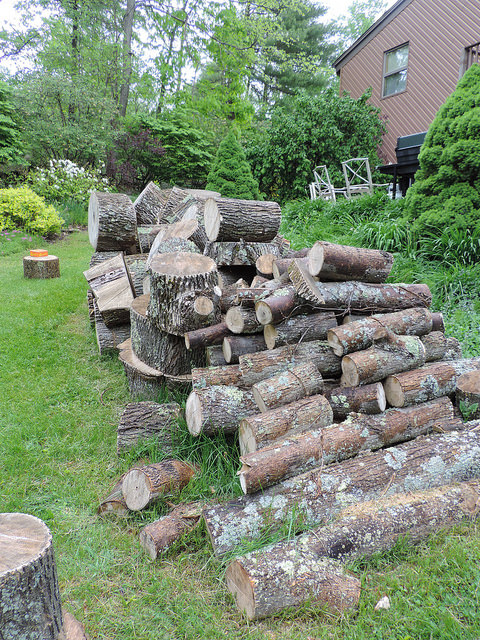Reprint of a 2015 article by Sarah Hatfield
I pulled in the driveway and the sky seemed to switch personalities from slight irritation to a bucket of anger upturned. The rain came in curtains and torrents, the wind chaotic. I watched through my sunroof as the tops of the yard maples spun and twisted and writhed. Out loud I wondered if today was the day one would split and come down.
With just as sudden a mood change, the rain subsided, the sun came out and the fresh raindrops on the grass glistened. It seemed peaceful and magical, the primary sound being the patter of the last drops through the leaves. Everything was remarkably still after the intense motion just past. The trees both stood, wet and drooping.
A phone call came shortly after. “Hey! Half of your maple tree is lying in the road.” Hmm. By the time I got home my neighbor was already there, sweat dripping down his face, chainsaw in hand. We had gazed up at those trees many times and contemplated how much firewood was in those trees.
Within an hour, with help from some extraordinarily generous friends and neighbors, the tree was out of the road, branches piled, and limbs cut into wood stove sized bites. Splitting the wood could wait.. Eighty degree heat and 98% humidity aren’t particularly compatible with splitting firewood.

Harvesting trees for firewood is labor intensive. If I counted how many times I handled each piece of wood before I finally fed it to the wood stove, I might actually decide that it is too much work! The fact that it is so more than work is what keeps me using it.
Physically, using firewood is a good workout. Moving, splitting, stacking, and moving again is good for arms, legs, and cardio. All year long firewood provides excellent toning workouts.
Mentally, it is therapy and meditation. The tasks are often monotonous, but with that comes a clearing of the mind. After I get past the point of thinking about all the other things I have to do, moving, splitting, or stacking firewood allows my mind to wander, cleanse itself, and recognize the truly important things in life. It is also gratification when I see the results of my work in a neat stack, a truck full, or a blazing fire.
Ecologically, I share the wood pile with so many others. There is always a stack of firewood, sometimes two years’ worth depending on the time of year, in the driveway. In that stack, wildlife finds shelter, food, and even homes. Whether it is the first little snake of spring, huddled for warmth near the top of the pile, or the long-legged crickets that lurk near the bottom, there are signs of life throughout. The firewood friends.
One rainy year I found a Slimy Salamander resting between pieces. With the abundance of slugs, insects and invertebrates there was little wondering why he chose that spot. To the amphibian list I can also add Red-backed Salamanders and toads. They prefer the bottom layers, shaded and cool, with close access to the damp earth beneath.
Snakes love the upper layers. The sun hits both early morning and evening, providing a therapeutic dose of vitamin D and warmth with which to start and end the day. I often find snakes in the wood pile before I find them anywhere else. Even when I don’t find the snakes themselves I always find shed skins. I’ve counted five different species of snakes using my wood pile, though there might be more.
Many rodents seek refuge in the wood pile, either from hungry predators, weather, or cold. Mouse nests made cozy with grass and chicken feathers are scattered throughout the layers. Caches of cherry pits, acorn shells, and scat denote favorite eating spots. Tunnels between the bottom layer and the dirt show the highways that the voles and mice use in the winter months as they travel between food and shelter.

Insects maintain a continuous presence both in the wood and between the pieces. Ants, beetles, bees, wasps, and moths are regular residents. This year I discovered a treasure. Out of the corner of my eye I caught a flash of green. After walking by a few times I finally investigated and found a Monarch Butterfly chrysalis suspended from one piece of firewood.
Perhaps the most rewarding friendship I have that often revolves around firewood is that with my neighbor. He loves any activity that involves firewood. Countless days I have come home and noticed the stack of firewood already split. There have been evenings that we have been out until his wife turns on the porch light, letting us know that is actually too dark to be working and we should cease. He understands well the benefits firewood provides.
Thanks to the wildlife and the friendships, I now better understand what using firewood truly is. It isn’t work or a chore. It is spending time with neighbors and friends. It is a workout. It is an escape. It is a window into the lives of wildlife. It is harvesting a renewable resource. It is sheltering wildlife. It is a sustainable transfer of energy from the yard to the wood stove, from the garden to my muscles. And while I don’t wish for the other half of the tree to fall, I won’t be sad when it does.
Audubon Community Nature Center builds and nurtures connections between people and nature. ACNC is located just east of Route 62 between Warren and Jamestown. The trails are open from dawn to dusk as is Liberty, the Bald Eagle. The Nature Center is open from 10 a.m. until 4:30 p.m. daily except Sunday when it opens at 1 p.m. More information can be found online at auduboncnc.org or by calling (716) 569-2345.
Sarah Hatfield is Education Coordinator at Audubon.


Recent Comments